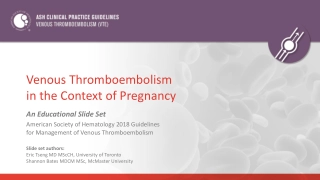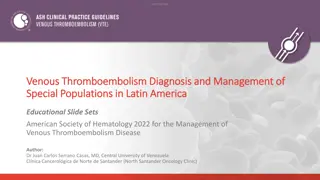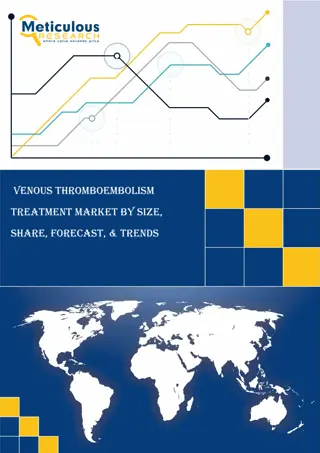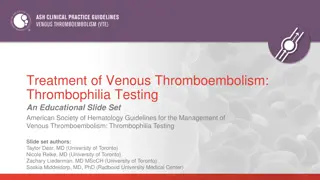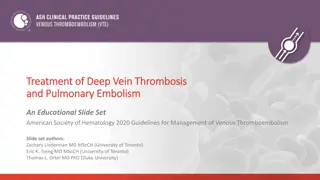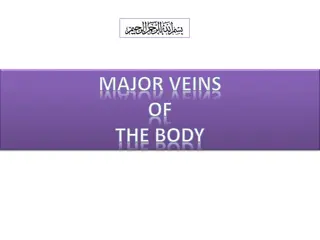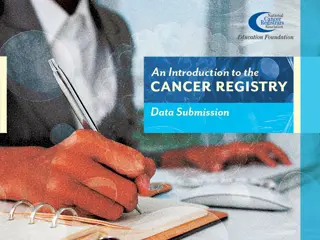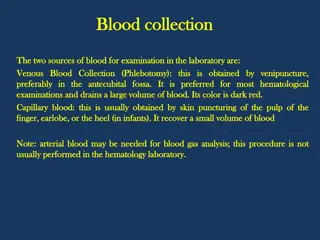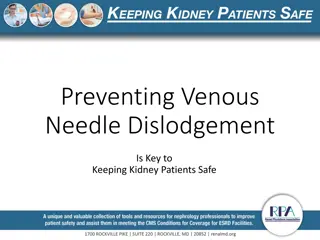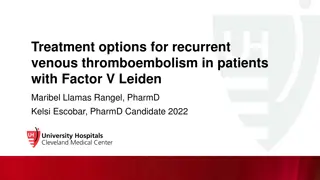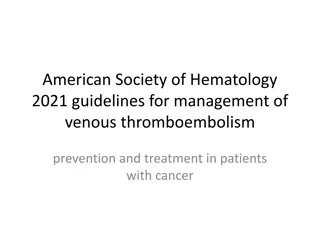Understanding the Association of Cancer and Venous Thromboembolism
VTE poses a significant risk for cancer patients, yet awareness of this link and its warning signs is lacking. The detection of VTE during cancer staging and its implications, including incidental findings and clinical correlates, highlight the need for proactive measures in managing this co-occurrence to improve patient outcomes.
Download Presentation

Please find below an Image/Link to download the presentation.
The content on the website is provided AS IS for your information and personal use only. It may not be sold, licensed, or shared on other websites without obtaining consent from the author. Download presentation by click this link. If you encounter any issues during the download, it is possible that the publisher has removed the file from their server.
E N D
Presentation Transcript
References: References: Despite the well-known association of VTE and cancer, patients are woefully unaware of that risk and of warning signs and symptoms: 1. Lyman GH, et al. Venous thromboembolism prophylaxis and treatment in patients with cancer: American Society of Clinical Oncology clinical practice guideline update. Journal of Clinical Oncology. 2013 May 13;31(17):2189-204. 2. Noble S, Matzdorff A, Maraveyaspatients' anticoagulation preferences for the treatment of cancer-associated thrombosis using conjoint methodology. Haematologica 2015; 100(11): 1486-92 VTE can be detected on imaging studies conducted for other indications, typically while staging cancer: 1. Khorana A. et al, Incidental Venous Thromboembolism in Oncology Patients. JTH 2012; Dec; 10(12): 2602-4 2. O Connell C.L, et al. Unsespected Pulmonary Emboli in Cancer Patients: Clinical Correlates and Relevance. JCO 2006; 24;4928-4932 3. Stein PD, et al. Chest 1995;110:978 81 4. Sander DA, et al. Autopsy proven pulmonary embolism in hospital patients: are we detecting enough deep vein thrombosis? J R Soc Med 1969;82:203 5. 5. Nicolaides AN, Fareed J, Kakkar AK, Breddin HK. Prevention and treatment of venous thromboembolism International Consensus Statement (guidelinesaccording to scientificevidence).International Angiology. 2006 Jun 1;25(2):101 High rates of incidental VTE: 1. Moore RA, Adel N, Riedel E, Bhutani M, Feldman DR, Tabbara NE, Soff G, Parameswaran R, Hassoun H. High incidence of thromboembolic events in patients treated with cisplatin-based chemotherapy: a large retrospective analysis. Journal of Clinical Oncology. 2011 Aug 1;29(25):3466-73. 2. Menapace LA, Peterson DR, Berry A et al. Symptomatic and incidental thromboembolism are both associated with mortality in pancreatic cancer. Thromb Haemost 2011;106:371 378 Similar outcomes for cancer patients with incidental & symptomatic PE: 1. Den Exter PL, Hooijer J, Dekkers OM, Huisman MV. Risk of recurrent venous thromboembolism and mortality in patients with cancer incidentally diagnosed with pulmonary embolism: a comparison with symptomatic patients. Journal of Clinical Oncology. 2011 May 9;29(17):2405-9.


